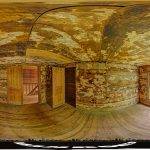Garnet Ghost Town: A Historical Gem in Montana
Nestled in the rugged terrain of Granite County, Montana, lies Garnet Ghost Town, a testament to the enduring allure of gold and the impermanence of human endeavors. Established in the late 19th century, Garnet’s story is one of rapid growth, decline, and eventual transformation into a ghost town. This post delves into the history of Garnet Ghost Town, exploring its establishment, flourishing years, decline, and current status as a preserved historical site. You can also view several 360-degree panoramic images captured around the Ghost Town on Google Maps Street View below.
Image by: Mateusz Chołody
Image by: Mateusz Chołody
Image by: Mateusz Chołody
Image by: Mateusz Chołody
Image by: Lonnie Huffman
The Birth of Garnet
Early Discoveries and the Gold Rush
The history of Garnet dates back to the 1860s when gold prospecting began in the Garnet Mountains. The initial discovery of gold in nearby areas like Bannack, Montana, in the early 1860s spurred interest in the region. In 1895, a significant development occurred when Dr. Armistead Mitchell built a stamp mill in what was then known as Mitchell, after his name. The discovery of garnet gemstones in the area led to the town being renamed Garnet.
The Boom Years
Garnet’s growth was meteoric. By 1898, the town was a bustling hub, with a population of about 1,000 residents. This boom was largely fueled by the success of the Nancy Hanks Mine, discovered in 1867, and other mining operations. At its peak, Garnet boasted schools, hotels, a doctor’s office, numerous saloons, stores, and other enterprises, essential for a thriving community.
The Life in Garnet
A Community Unlike Any Other
Unlike many mining towns focused solely on mining, Garnet was a more family-oriented community. It had a vibrant social life with events like parties and dances. Gambling was also a big part of the culture. The town had everything a Wild West town needed, from hotels and saloons to barbershops and stores, catering to both the miners and their families.
The Decline of Garnet
The Factors Leading to Abandonment
The decline of Garnet was a combination of several factors. The yield of gold began to diminish in the early 20th century, making mining less profitable. By 1905, many mines were abandoned, and the population dwindled to around 150 people. A devastating fire in 1912 destroyed many of the town’s buildings, exacerbating its decline. World Wars I and II further impacted the town, as many left to join the war efforts or seek employment elsewhere. By the early 1940s, Garnet was virtually deserted.
Economic Changes
Economic changes also played a role. The value of gold extracted from Garnet was significant for the time, but as gold prices fluctuated and mining costs rose, the town’s economic foundation crumbled. A brief resurgence in the 1930s, when gold prices rose, was not enough to sustain the community.
Preservation Efforts
Bureau of Land Management and Garnet Preservation Association
In the years following its abandonment, Garnet’s buildings suffered from deterioration, vandalism, and the harsh Montana weather. Recognizing the historical value of Garnet, the Bureau of Land Management, in partnership with the Garnet Preservation Association, took steps in 1971 to preserve the town. Their joint efforts have been pivotal in maintaining Garnet as one of Montana’s best-preserved ghost towns.
Historical Recognition
In 2010, Garnet was officially listed on the National Register of Historic Places. This recognition has helped protect and promote the town as a significant historical site. Today, Garnet stands as a window into the past, showcasing the lifestyle and challenges of those who lived through the gold rush era.
Garnet Today
A Tourist Attraction and Educational Site
Despite its quiet demeanor now, especially under the heavy snows of the Garnet Mountain Range, the town remains a popular tourist attraction, drawing thousands of visitors annually. It is celebrated for its well-preserved state, offering a glimpse into the late 19th and early 20th-century mining life in Montana.
Celebrating Garnet’s Legacy
Each year, Garnet Ghost Town is celebrated with an annual event, Garnet Day, attracting visitors and history enthusiasts. The town’s oldest living member, Mary Jane Adams Morin, was known to visit annually, highlighting the personal connections that still exist to this historic place.
Conclusion
Garnet Ghost Town serves as a poignant reminder of the transient nature of boomtowns that once dotted the American West. Its story is one of hope, prosperity, and eventual decline, mirroring the fortunes of the mining industry it was built upon. Today, Garnet stands as a well-preserved monument to this fascinating chapter in American history, offering insights and lessons about the past while captivating the imaginations of those who walk its deserted streets.
If you liked this post, you might like these as well, the Harry T. Moore & Harriette Moore Home in Florida, the Jim Hannah Cabin in North Carolina, or the Blub Swimming and Leisure Center in Germany.

A 360-degree panoramic image captured in the heart of the Garnet Ghost Town in Montana. Image by: Mateusz Chołody
Do you have 360-degree panoramic images captured in an abandoned location? Send your images to Abandonedin360@gmail.com. If you choose to go out and do some urban exploring in your town, here are some safety tips before you head out on your Urbex adventure.
Unlock the secrets of exploration by diving into precise GPS data available exclusively for an array of hidden gems and hundreds of other captivating sites, all within our members’ section. By investing in a Gold Membership, you’re not just gaining access; you’re securing a key to a vast, global archive of abandoned, untouched, and mysterious locations waiting to be discovered. Embark on your adventure with confidence, knowing every corner of the world can be within your reach. Don’t just observe—explore, discover, and claim the extraordinary journey that lies ahead with our treasure trove of world secrets. Subscribe now and transform the way you see the world!
Click on a state below and explore the top abandoned places for urban exploring in that state.






